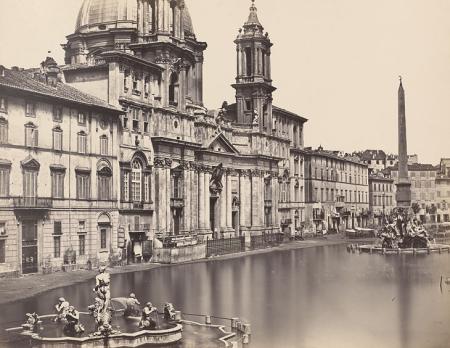
1862

1972
The grand and picturesque old Piazza Navona...offers in the month of August a spectacle which plainly recalls the old fontali. On Saturday evening all the benches and booths are removed, and the great drain which carries away the water spilled by the three fountains is closed. The basins then fill and pour over into the square, till in a few hours it is transformed into a shallow, shining lake, out of which, like islands, emerge the fountains with their obelisks and figures, and in whose clear mirror are reflected the cupola of St. Agnese and St. Giacomo, the ornate facades of the Doria, Pamfili, and Braschi Palaces, and all the picturesque houses by which it is enclosed. ...Carriages welter nave-deep in the water, and spatter recklessly about; whips crack madly on all sides like the going off of a thousand sharp India crackers; and horses plunge and snort with excitement, sometimes overturning their carriages and giving the passengers an improvised bath.
—William Wetmore Story, Roba di Roma, II, 495–496
The Piazza Navona preserves the shape of the ancient Stadium of Domitian, which provides foundations for the buildings that enclose it. In the seventeenth century, it was transformed into one of the great piazzas of Baroque Rome by Pope Innocent x. Bernini’s Fountain of the Moor occupies the foreground; the figure’s serpentine pose is set off against the dark, reflective surface of the water, while the sculptor’s Four Rivers Fountain appears in the distance. During the summer months, the drains of the fountains were occasionally closed and the piazza flooded. Anderson’s photograph records the early stages of this festive diversion.
James Anderson, The Piazza Navona Flooded, ca. 1862. Collection W. Bruce and Delaney H. Lundberg. Photography by Graham S. Haber
Location photography by John Pinto
